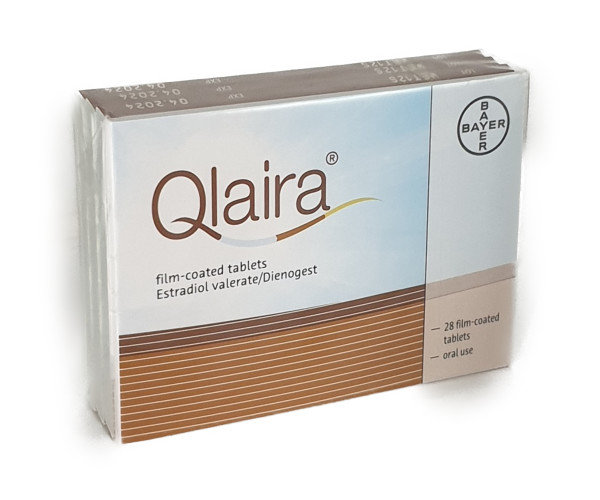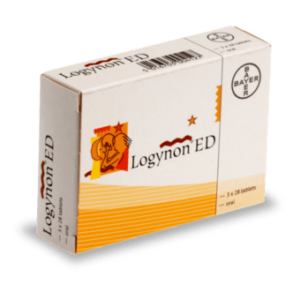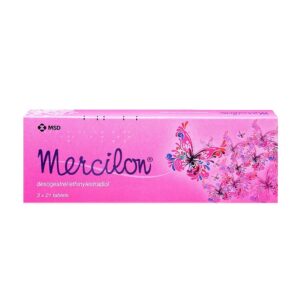Description
Qlaira is a contraceptive pill and is used to prevent pregnancy.
- Qlaira is used for the treatment of heavy menstrual bleeding (not caused by any
disease of the womb) in women who wish to use oral contraception.
- Each coloured active tablet contains a small amount of female hormones, either
estradiol valerate, or estradiol valerate combined with dienogest.
- The 2 white tablets. contain no active substances and are called inactive tablets
- Contraceptive pills that contain two hormones are called “combined pills”.
Uses / Instructions
Take one tablet of Qlaira every day, if necessary with a small amount of water. You may take the tablets with or without food, but you should take the tablets at around the same time every day
Warnings
Tell your doctor if any of the following conditions apply to you.
In some situations you need to take special care while taking Qlaira or any other combined pill, and your doctor may need to examine you regularly. If the condition develops, or gets worse while you are using Qlaira, you should also tell your doctor.
- if a close relative has or has ever had breast cancer
- if you have a disease of the liver or gall bladder
- if you have jaundice
- if you have diabetes
- if you have depression
- if you have Crohn’s disease or ulcerative colitis (chronic inflammatory bowel disease);
- if you have systemic lupus erythematosus (SLE – a disease affecting your natural defence system);
- if you have haemolytic uraemic syndrome (HUS – a disorder of blood clotting causing failure of the kidneys);
- if you have sickle cell anaemia (an inherited disease of the red blood cells);
- if you have elevated levels of fat in the blood (hypertriglyceridaemia) or a positive family history for this condition. Hypertriglyceridaemia has been associated with an increased risk of developing pancreatitis (inflammation of the pancreas);
- if you need an operation, or you are off your feet for a long time.
- if you have just given birth you are at an increased risk of blood clots. You should ask your doctor how soon after delivery you can start taking Qlaira.
- if you have an inflammation in the veins under the skin (superficial thrombophlebitis).
- if you have varicose veins.
- if you have epilepsy (see “Other medicines and Qlaira”)
- if you have a disease that first appeared during pregnancy or earlier use of sex hormones, for example, hearing loss, porphyria (a disease of the blood), gestational herpes (skin rash with blisters during pregnancy), Sydenham’s chorea (a nerve disease causing sudden movements of the body)
- if you have (or have ever had) golden brown pigment patches so-called “pregnancy patches” especially on the face (Chloasma). If this is the case, avoid direct exposure to sunlight or ultraviolet light
- if you have hereditary angioedema. Consult your doctor immediately if you experience symptoms of angioedema such as swollen face, tongue and/or throat and/or difficulty swallowing or hives, together with difficulty breathing. Products containing oestrogens may induce or worsen symptoms of angioedema
- if you have cardiac or renal insufficiency
See patient information leaflet for more details.
Side Effects
Like all medicines, Qlaira can cause side effects, although not everybody gets them.
Common side effects (between 1 and 10 in every 100 users may be affected):
– headache
– abdominal pain, nausea
– acne
– no periods, breast discomfort, painful periods, irregular bleeding (heavy irregular bleeding)
– weight gain
Uncommon side effects (between 1 and 10 in every 1,000 users may be affected):
– fungal infections, fungal infection of the vulva and vagina, vaginal infection
– increased appetite
– depression, depressed mood, emotional disorder, problems sleeping, decreased interest in sex, mental disorder, mood swings
– dizziness, migraine
– hot flush, high blood pressure
– diarrhoea, vomiting
– increased liver enzymes
– hair loss, excessive sweating (hyperhidrosis), itching, rash
– muscle cramps
– swollen breasts, lumps in the breast, abnormal cell growth on the neck of the womb
(cervical dysplasia), dysfunctional genital bleeding, pain with intercourse, fibrocystic breast disease, heavy periods, menstrual disorders, ovarian cyst, pelvic pain, premenstrual syndrome, growth in the uterus, contractions of the uterus, uterine/vaginal bleeding incl. spotting, vaginal discharge, vulvovaginal dryness
– fatigue, irritability, swelling of parts of your body, e.g. ankles (oedema)
– weight loss, blood pressure changes.
Ingredients
The active substances are estradiol valerate, or estradiol valerate combined with dienogest.
Other ingredients in the coloured active tablets are:
Tablet core: lactose monohydrate, maize starch, pregelatinised maize starch, povidone K25 (E1201), magnesium stearate (E572)
Tablet film-coating: hypromellose type 2910 (E464), macrogol 6000, talc (E553b), titanium dioxide (E171), iron oxide yellow (E172) and/or iron oxide red (E172)
Other ingredients in the white inactive tablets are:
Tablet core: lactose monohydrate, maize starch, povidone K25 (E1201), magnesium stearate (E572)
Tablet film-coating: hypromellose type 2910 (E464), talc (E553b), titanium dioxide (E171)







Reviews
There are no reviews yet.